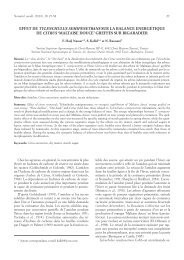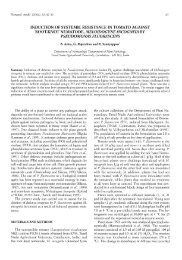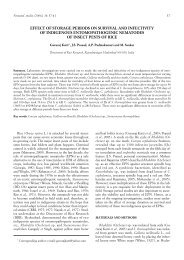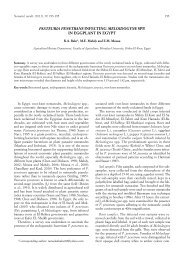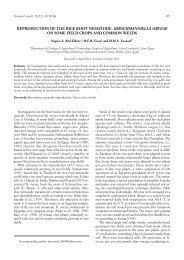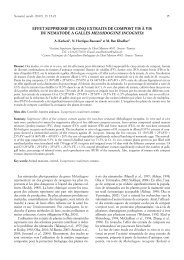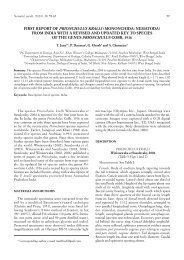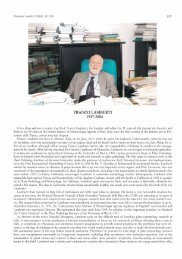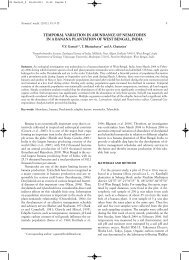M.S. RAO Management of Meloidogyne javanica on acid lime ...
M.S. RAO Management of Meloidogyne javanica on acid lime ...
M.S. RAO Management of Meloidogyne javanica on acid lime ...
You also want an ePaper? Increase the reach of your titles
YUMPU automatically turns print PDFs into web optimized ePapers that Google loves.
Nematol. medit. (2005), 33: 145-148 145<br />
MANAGEMENT OF MELOIDOGYNE JAVANICA ON ACID LIME<br />
NURSERY SEEDLINGS BY USING FORMULATIONS<br />
OF POCHONIA CHLAMYDOSPORIA AND PAECILOMYCES LILACINUS<br />
M.S. Rao<br />
Nematology Laboratory, Divisi<strong>on</strong> <str<strong>on</strong>g>of</str<strong>on</strong>g> Entomology and Nematology, Indian Institute <str<strong>on</strong>g>of</str<strong>on</strong>g> Horticultural Research,<br />
Hessaraghatta Lake P.O., Bangalore 560 089, India<br />
Summary. Bio-efficacy and compatibility <str<strong>on</strong>g>of</str<strong>on</strong>g> formulati<strong>on</strong>s <str<strong>on</strong>g>of</str<strong>on</strong>g> Poch<strong>on</strong>ia chlamydosporia (2×10 6 cfu/g) and Paecilomyces lilacinus<br />
(2×10 6 cfu/g) <strong>on</strong> root-knot nematode, <str<strong>on</strong>g>Meloidogyne</str<strong>on</strong>g> <str<strong>on</strong>g>javanica</str<strong>on</strong>g>, infecting nursery seedlings <str<strong>on</strong>g>of</str<strong>on</strong>g> <strong>acid</strong> <strong>lime</strong> were evaluated. Applicati<strong>on</strong><br />
<str<strong>on</strong>g>of</str<strong>on</strong>g> 5 or 10 g <str<strong>on</strong>g>of</str<strong>on</strong>g> each bio-agent formulati<strong>on</strong> per kg <str<strong>on</strong>g>of</str<strong>on</strong>g> soil significantly reduced root-galling index and the number <str<strong>on</strong>g>of</str<strong>on</strong>g> nematodes in<br />
the roots. The combined use <str<strong>on</strong>g>of</str<strong>on</strong>g> P. lilacinus and P. chlamydosporia, each at 10 g/kg, significantly reduced rhizosphere col<strong>on</strong>izati<strong>on</strong><br />
and the soil propagule density <str<strong>on</strong>g>of</str<strong>on</strong>g> P. chlamydosporia compared to the densities achieved when the fungus was applied al<strong>on</strong>e. However,<br />
the root col<strong>on</strong>izati<strong>on</strong> and soil propagule density <str<strong>on</strong>g>of</str<strong>on</strong>g> P. lilacinus were not affected when it was used at both the dosages (5 and<br />
10 g) <str<strong>on</strong>g>of</str<strong>on</strong>g> P. chlamydosporia. The seedling roots were col<strong>on</strong>ised by both bio-agents. These data will be useful for the development <str<strong>on</strong>g>of</str<strong>on</strong>g><br />
a combined formulati<strong>on</strong> <str<strong>on</strong>g>of</str<strong>on</strong>g> the two bio-agents.<br />
<str<strong>on</strong>g>Meloidogyne</str<strong>on</strong>g> <str<strong>on</strong>g>javanica</str<strong>on</strong>g> (Treub) Chitw. is reported as <strong>on</strong>e<br />
<str<strong>on</strong>g>of</str<strong>on</strong>g> the important factors affecting the producti<strong>on</strong> <str<strong>on</strong>g>of</str<strong>on</strong>g> <strong>acid</strong><br />
<strong>lime</strong> (Citrus aurantifolia Christm et Panz) in India (Mani,<br />
1986; McSorley, 1981; Reddy and Rao, 2001). During<br />
surveys <str<strong>on</strong>g>of</str<strong>on</strong>g> <strong>acid</strong> <strong>lime</strong> orchards in southern states <str<strong>on</strong>g>of</str<strong>on</strong>g> India,<br />
very high incidences <str<strong>on</strong>g>of</str<strong>on</strong>g> M. <str<strong>on</strong>g>javanica</str<strong>on</strong>g> were observed (Reddy<br />
and Rao, 2001). Mani (1986) also reported that M. <str<strong>on</strong>g>javanica</str<strong>on</strong>g><br />
caused severe crop loss <str<strong>on</strong>g>of</str<strong>on</strong>g> <strong>acid</strong> <strong>lime</strong> in south India.<br />
Since the use <str<strong>on</strong>g>of</str<strong>on</strong>g> chemical nematicides has proved to be<br />
hazardous, it was thought to develop a method <str<strong>on</strong>g>of</str<strong>on</strong>g> management<br />
using a formulati<strong>on</strong> <str<strong>on</strong>g>of</str<strong>on</strong>g> the fungus Poch<strong>on</strong>ia<br />
chlamydosporia Zare et al., which was reported to be a<br />
very effective bio-c<strong>on</strong>trol agent against root-knot nematodes<br />
(De Leij and Kerry, 1991; Kerry et al., 1993; Rao et<br />
al., 1997c, 1998a, 2003). Paecilomyces lilacinus (Thom.)<br />
Sams<strong>on</strong> was also reported to be effective against rootknot<br />
nematodes (Jatala, 1986; Rao and Reddy, 1994; Reddy<br />
et al., 1999; Rao et al., 1997a, 1997b, 1998b, 1999).<br />
However, there are no reports <strong>on</strong> the combined use <str<strong>on</strong>g>of</str<strong>on</strong>g><br />
these two promising bio-agents for the management <str<strong>on</strong>g>of</str<strong>on</strong>g><br />
root-knot nematodes <strong>on</strong> <strong>acid</strong> <strong>lime</strong> nursery seedlings.<br />
Hence, the present investigati<strong>on</strong>s were carried out.<br />
MATERIALS AND METHODS<br />
Local isolates <str<strong>on</strong>g>of</str<strong>on</strong>g> P. lilacinus (IIHR-PL 2) and P.<br />
chlamydosporia (IIHR-VC 3) were mass produced separately<br />
through liquid and solid fermentati<strong>on</strong> processes<br />
(the details <str<strong>on</strong>g>of</str<strong>on</strong>g> the fermentati<strong>on</strong> process are not revealed<br />
here for patent c<strong>on</strong>siderati<strong>on</strong>s). The identificati<strong>on</strong> <str<strong>on</strong>g>of</str<strong>on</strong>g> P.<br />
chlamydosporia was c<strong>on</strong>firmed by Pr<str<strong>on</strong>g>of</str<strong>on</strong>g>. Brian Kerry,<br />
*<br />
IIAR c<strong>on</strong>tributi<strong>on</strong> No. 10/2005.<br />
Rothamsted Research, United Kingdom (pers<strong>on</strong>al communicati<strong>on</strong>,<br />
2000), by a diagnostic test based <strong>on</strong> specific<br />
primers from the b tubulin gene used in PCR (Arora et<br />
al., 1996). In the field experiments, products (formulated<br />
at Indian Institute <str<strong>on</strong>g>of</str<strong>on</strong>g> Horticultural Research, Bangalore,<br />
India) <str<strong>on</strong>g>of</str<strong>on</strong>g> P. lilacinus (2 × 10 6 spores/g) and P.<br />
chlamydosporia (2 × 10 6 chlamydospores/g) were evaluated,<br />
each at dosages <str<strong>on</strong>g>of</str<strong>on</strong>g> 5 and 10 g per kg <str<strong>on</strong>g>of</str<strong>on</strong>g> soil.<br />
The experiment was c<strong>on</strong>ducted at the Indian Institute<br />
<str<strong>on</strong>g>of</str<strong>on</strong>g> Horticultural Research, Bangalore, for two seas<strong>on</strong>s<br />
during 2002 and 2003 (June to November). The<br />
nursery soil (a mixture <str<strong>on</strong>g>of</str<strong>on</strong>g> soil, farm yard manure and<br />
sand in the ratio <str<strong>on</strong>g>of</str<strong>on</strong>g> 3:2:1) was infested with 89 + 5<br />
hatched juveniles <str<strong>on</strong>g>of</str<strong>on</strong>g> M. <str<strong>on</strong>g>javanica</str<strong>on</strong>g> per 100 g <str<strong>on</strong>g>of</str<strong>on</strong>g> soil. The<br />
soil was mixed with the bio-agent formulati<strong>on</strong>s and 1 kg<br />
<str<strong>on</strong>g>of</str<strong>on</strong>g> mixture was added to polythene bags (10 × 15 cm).<br />
One seed <str<strong>on</strong>g>of</str<strong>on</strong>g> <strong>acid</strong> <strong>lime</strong> was sown in each bag. The treatments<br />
were: a) soil mixed with P. lilacinus at 5 g/kg, b)<br />
soil mixed with P. lilacinus at 10 g/kg, c) soil mixed with<br />
P. chlamydosporia at 5 g/kg, d) soil mixed with P.<br />
chlamydosporia at 10 g/kg, e) soil mixed with P. lilacinus<br />
and P. chlamydosporia at 5 g each/kg, f) soil mixed with<br />
P. lilacinus and P. chlamydosporia at 10 g each/kg, and g)<br />
c<strong>on</strong>trol with no treatment. Each treatment was replicated<br />
ten times in a completely randomized block design.<br />
Observati<strong>on</strong>s <strong>on</strong> length <str<strong>on</strong>g>of</str<strong>on</strong>g> seedlings, seedling weight,<br />
root-galling index <strong>on</strong> a 1-10 scale (Bridge and Page,<br />
1980), number <str<strong>on</strong>g>of</str<strong>on</strong>g> eggs/egg mass, root col<strong>on</strong>isati<strong>on</strong> by P.<br />
lilacinus and P. chlamydosporia, soil propagule densities<br />
<str<strong>on</strong>g>of</str<strong>on</strong>g> both bio-agents, and soil nematode populati<strong>on</strong> densities<br />
were recorded 150 days after sowing.<br />
To evaluate root col<strong>on</strong>isati<strong>on</strong> by P. lilacinus and P.<br />
chlamydosporia, five seedlings were uprooted. Each root<br />
system was carefully washed to remove soil and excess<br />
water was removed using blotting paper. Root systems
146<br />
were weighed and cut into small pieces about 1 cm<br />
l<strong>on</strong>g. Two grams <str<strong>on</strong>g>of</str<strong>on</strong>g> root pieces were picked at random<br />
from each seedling to make a composite sample <str<strong>on</strong>g>of</str<strong>on</strong>g> 10<br />
grams from the five plants taken from the ten replicates<br />
(the remaining five replicates were used for other observati<strong>on</strong>s).<br />
Out <str<strong>on</strong>g>of</str<strong>on</strong>g> this composite sample, 1-g samples <str<strong>on</strong>g>of</str<strong>on</strong>g><br />
roots were taken for estimati<strong>on</strong> <str<strong>on</strong>g>of</str<strong>on</strong>g> root col<strong>on</strong>izati<strong>on</strong> by<br />
P. lilacinus and P. chlamydosporia separately, using the<br />
semi-selective media developed by Mitchell et al. (1987)<br />
and Kerry et al. (1993), respectively. Petri plates were<br />
incubated in an incubator at 25-27 °C for 15 days. Soil<br />
propagule densities <str<strong>on</strong>g>of</str<strong>on</strong>g> both bio-agents were estimated<br />
by following a serial diluti<strong>on</strong> technique and using the<br />
above-menti<strong>on</strong>ed semi-selective media.<br />
To determine the number <str<strong>on</strong>g>of</str<strong>on</strong>g> eggs per egg mass, two<br />
egg masses <str<strong>on</strong>g>of</str<strong>on</strong>g> M. <str<strong>on</strong>g>javanica</str<strong>on</strong>g> were randomly selected from<br />
each plant. The ten egg masses collected from five<br />
plants were dissolved in 0.05% sodium hypochlorite soluti<strong>on</strong><br />
(Hussey and Barker, 1973) and the number <str<strong>on</strong>g>of</str<strong>on</strong>g><br />
eggs was counted. To investigate parasitism <str<strong>on</strong>g>of</str<strong>on</strong>g> the eggs<br />
by P. lilacinus or P. chlamydosporia, two egg masses were<br />
again randomly selected from each <str<strong>on</strong>g>of</str<strong>on</strong>g> the five plants and<br />
the ten egg masses were treated with 0.01% sodium<br />
hypochlorite in a Petri plate for 60 sec<strong>on</strong>ds, for surface<br />
sterilizati<strong>on</strong>. The eggs from these egg masses were dispersed<br />
in 3 ml <str<strong>on</strong>g>of</str<strong>on</strong>g> sterile water using a blender (Jenc<strong>on</strong>s)<br />
and plated <strong>on</strong> the semi-selective medium developed by<br />
Mitchell et al. (1987) and Kerry et al. (1993). Petri<br />
plates were incubated at 25-27 °C for 4 days and infected<br />
eggs were readily identified. The proporti<strong>on</strong>s <str<strong>on</strong>g>of</str<strong>on</strong>g> the<br />
eggs infected by the fungi were determined by examinati<strong>on</strong><br />
<str<strong>on</strong>g>of</str<strong>on</strong>g> 100 eggs <strong>on</strong> each Petri plate.<br />
The fungi, P. lilacinus and P. chlamydosporia, were isolated<br />
from adult females <str<strong>on</strong>g>of</str<strong>on</strong>g> M. <str<strong>on</strong>g>javanica</str<strong>on</strong>g> by using the semi-selective<br />
media menti<strong>on</strong>ed above. Females were incubated<br />
in Petri plates at 25-27 °C for 15 days in the dark<br />
and, <strong>on</strong> the basis <str<strong>on</strong>g>of</str<strong>on</strong>g> morphological features <str<strong>on</strong>g>of</str<strong>on</strong>g> P. lilacinus<br />
and P. chlamydosporia, parasitism <str<strong>on</strong>g>of</str<strong>on</strong>g> adult females was<br />
c<strong>on</strong>firmed. Root populati<strong>on</strong>s <str<strong>on</strong>g>of</str<strong>on</strong>g> the nematodes were estimated<br />
from 10-g composite samples <str<strong>on</strong>g>of</str<strong>on</strong>g> roots, collected<br />
from five replicates at 2 g/replicate. The root samples<br />
were stained using <strong>acid</strong> fuchsin following the method <str<strong>on</strong>g>of</str<strong>on</strong>g><br />
Bridge et al. (1982), homogenised, and the numbers <str<strong>on</strong>g>of</str<strong>on</strong>g><br />
nematodes (J 2<br />
and adults) counted. To estimate the reducti<strong>on</strong><br />
in the soil nematode density due to the applicati<strong>on</strong><br />
<str<strong>on</strong>g>of</str<strong>on</strong>g> P. chlamydosporia, P. lilacinus or both organisms,<br />
the infective stage juveniles <str<strong>on</strong>g>of</str<strong>on</strong>g> M. <str<strong>on</strong>g>javanica</str<strong>on</strong>g> were extracted<br />
from 100 cm 3 soil per replicate by Cobb’s sieving and<br />
decanting method (Cobb, 1918) and counted.<br />
The data were analyzed using ANOVA.<br />
RESULTS AND DISCUSSION<br />
Soil treatment with the combinati<strong>on</strong> <str<strong>on</strong>g>of</str<strong>on</strong>g> P. lilacinus and<br />
P. chlamydosporia significantly reduced the root galling<br />
index to 3.0 and 3.5 at dosages <str<strong>on</strong>g>of</str<strong>on</strong>g> 5 and 10 g/kg, respectively,<br />
in seas<strong>on</strong> 2 (Table I); untreated plants had a<br />
galling index <str<strong>on</strong>g>of</str<strong>on</strong>g> 8.4 (Table I). Paecilomyces lilacinus was<br />
also found effective against M. <str<strong>on</strong>g>javanica</str<strong>on</strong>g> <strong>on</strong> potato and<br />
tomato, Globodera rostochiensis (Wollenweber) Skarbilovich<br />
<strong>on</strong> potato, Tylenchulus semipenetrans Cobb <strong>on</strong><br />
citrus, and Rotylenchulus reniformis Linford et Oliveira<br />
<strong>on</strong> tomato and egg plant (Reddy and Khan, 1988, 1989;<br />
Rao et al., 2001).<br />
When the efficacy <str<strong>on</strong>g>of</str<strong>on</strong>g> individual treatments with these<br />
bio-agents was compared, P. lilacinus was found to be<br />
comparatively more effective than P. chlamydosporia in<br />
reducing the galling index, the number <str<strong>on</strong>g>of</str<strong>on</strong>g> nematodes in<br />
roots and soil, and the number <str<strong>on</strong>g>of</str<strong>on</strong>g> eggs per egg mass<br />
(Tables I and II). Moreover, this treatment significantly<br />
decreased the root galling index, the number <str<strong>on</strong>g>of</str<strong>on</strong>g> eggs<br />
per egg mass and total number <str<strong>on</strong>g>of</str<strong>on</strong>g> nematodes in roots<br />
when compared with treatments <str<strong>on</strong>g>of</str<strong>on</strong>g> individual bioagents<br />
(Tables I and II).<br />
The combined use <str<strong>on</strong>g>of</str<strong>on</strong>g> P. lilacinus and P. chlamydosporia,<br />
each at 10 g/kg soil, significantly reduced root col<strong>on</strong>isati<strong>on</strong><br />
by and soil propagule density <str<strong>on</strong>g>of</str<strong>on</strong>g> P. chlamydosporia<br />
in both seas<strong>on</strong>s (Table IV) but, when both bio-agents<br />
were used at 5 g/kg, neither affected the col<strong>on</strong>isati<strong>on</strong> <str<strong>on</strong>g>of</str<strong>on</strong>g><br />
the other (Table IV). Further, root col<strong>on</strong>isati<strong>on</strong> and soil<br />
Table I. Effects <str<strong>on</strong>g>of</str<strong>on</strong>g> Poch<strong>on</strong>ia chlamydosporia and Paecilomyces lilacinus, singly or in combinati<strong>on</strong>, <strong>on</strong> the growth <str<strong>on</strong>g>of</str<strong>on</strong>g> <strong>acid</strong> <strong>lime</strong><br />
seedlings and their infestati<strong>on</strong> by <str<strong>on</strong>g>Meloidogyne</str<strong>on</strong>g> <str<strong>on</strong>g>javanica</str<strong>on</strong>g>.<br />
Treatment<br />
Seedling<br />
height (cm)<br />
Seedling<br />
weight (g)<br />
Root-galling<br />
index (1-10)<br />
Seas<strong>on</strong> 1 Seas<strong>on</strong> 2 Seas<strong>on</strong> 1 Seas<strong>on</strong> 2 Seas<strong>on</strong> 1 Seas<strong>on</strong> 2<br />
P. lilacinus at 5 g/kg (Pl-5) 34.6 32.8 7.2 7.1 5.5 5.6<br />
P. lilacinus at 10 g/kg (Pl-10) 36.4 37.6 7.9 8.1 5.1 5.0<br />
P. chlamydosporia at 5 g/kg (Pc-5) 33.1 32.2 6.9 6.7 6.2 6.3<br />
P. chlamydosporia at 10 g/kg (Pc-10) 34.6 35.4 7.1 6.8 5.9 5.4<br />
Pl-5 + Pc-5 36.5 37.2 7.1 8.0 3.2 3.0<br />
Pl-10 + Pc-10 36.2 35.3 6.9 7.2 3.8 3.5<br />
Untreated 26.8 28.2 5.2 5.8 7.9 8.4<br />
C.D. (P = 0.05) 4.56 5.69 1.67 1.34 0.54 0.68<br />
C.D. = Critical Difference
Rao 147<br />
propagule density <str<strong>on</strong>g>of</str<strong>on</strong>g> P. lilacinus were not affected when it<br />
was used at either dose <str<strong>on</strong>g>of</str<strong>on</strong>g> P. chlamydosporia (Table IV).<br />
Treatment <str<strong>on</strong>g>of</str<strong>on</strong>g> nursery soil with formulati<strong>on</strong>s <str<strong>on</strong>g>of</str<strong>on</strong>g> both P.<br />
lilacinus and P. chlamydosporia, each at the rate <str<strong>on</strong>g>of</str<strong>on</strong>g> 5 g/kg<br />
<str<strong>on</strong>g>of</str<strong>on</strong>g> soil, increased the growth <str<strong>on</strong>g>of</str<strong>on</strong>g> <strong>acid</strong> <strong>lime</strong> seedlings (Tables<br />
I). The data also indicate that these rates are sufficient<br />
to c<strong>on</strong>trol M. <str<strong>on</strong>g>javanica</str<strong>on</strong>g> and that they avoid the competiti<strong>on</strong><br />
between the bio-agents observed when both<br />
fungi were used at 10 g/kg <str<strong>on</strong>g>of</str<strong>on</strong>g> soil (Tables III). Root<br />
col<strong>on</strong>isati<strong>on</strong> is an important criteri<strong>on</strong> for assessing the<br />
bio-efficacy <str<strong>on</strong>g>of</str<strong>on</strong>g> any formulated product, as the transplanted<br />
seedlings would carry the bio-agents to the field.<br />
Table II. Effects <str<strong>on</strong>g>of</str<strong>on</strong>g> combinati<strong>on</strong>s <str<strong>on</strong>g>of</str<strong>on</strong>g> P. chlamydosporia and P. lilacinus <strong>on</strong> root and soil populati<strong>on</strong>s <str<strong>on</strong>g>of</str<strong>on</strong>g> M. <str<strong>on</strong>g>javanica</str<strong>on</strong>g>.<br />
Treatment<br />
Nematodes (J 2 and adults)<br />
in 10 g roots<br />
Nematodes (J 2 ) in 100 cm 3<br />
<str<strong>on</strong>g>of</str<strong>on</strong>g> soil<br />
Eggs<br />
per egg-mass<br />
Seas<strong>on</strong> 1 Seas<strong>on</strong> 2 Seas<strong>on</strong> 1 Seas<strong>on</strong> 2 Seas<strong>on</strong> 1 Seas<strong>on</strong> 2<br />
P. lilacinus at 5 g/kg (Pl-5) 76 72 85 80 342 331<br />
P. lilacinus at 10 g/kg (Pl-10) 64 67 72 78 320 315<br />
P. chlamydosporia at 5 g/kg (Pc-5) 82 85 92 90 389 360<br />
P. chlamydosporia at 10 g/kg (Pc-10) 74 70 81 85 363 349<br />
Pl-5 + Pc-5 47 49 58 52 274 269<br />
Pl-10 + Pc-10 65 60 69 74 289 301<br />
Untreated 97 96 142 134 476 459<br />
C.D. (P = 0.05) 6.8 7.4 9.3 8.4 35.9 32.8<br />
C.D. = Critical Difference.<br />
Table III. Effects <str<strong>on</strong>g>of</str<strong>on</strong>g> a combinati<strong>on</strong> <str<strong>on</strong>g>of</str<strong>on</strong>g> P. chlamydosporia and P. lilacinus <strong>on</strong> the parasitisati<strong>on</strong> <str<strong>on</strong>g>of</str<strong>on</strong>g> eggs <str<strong>on</strong>g>of</str<strong>on</strong>g> M. <str<strong>on</strong>g>javanica</str<strong>on</strong>g>.<br />
Treatment<br />
% eggs parasitised by<br />
P. lilacinus<br />
% eggs parasitised by<br />
P. chlamydosporia<br />
Seas<strong>on</strong> 1 Seas<strong>on</strong> 2 Seas<strong>on</strong> 1 Seas<strong>on</strong> 2<br />
P. lilacinus at 5 g/kg (Pl-5) 43.9 45.9 0.0 0.0<br />
P. lilacinus at 10 g/kg (Pl-10) 57.4 66.5 0.0 0.0<br />
P. chlamydosporia at 5 g/kg (Pc-5) 0.0 0.0 51.9 55.8<br />
P. chlamydosporia at10 g/kg (Pc-10) 0.0 0.0 58.9 55.4<br />
Pl-5 + Pc-5 40.7 42.7 40.8 38.1<br />
Pl-10 + Pc-10 56.9 53.9 30.8 32.9<br />
Untreated 0.0 0.0 0.0 0.0<br />
C.D. (P = 0.05) 9.6 8.4 7.6 8.5<br />
C.D. = Critical Difference.<br />
Table IV. Effect <str<strong>on</strong>g>of</str<strong>on</strong>g> a combinati<strong>on</strong> <str<strong>on</strong>g>of</str<strong>on</strong>g> P. chlamydosporia and P. lilacinus <strong>on</strong> the col<strong>on</strong>isati<strong>on</strong> <str<strong>on</strong>g>of</str<strong>on</strong>g> roots <str<strong>on</strong>g>of</str<strong>on</strong>g> <strong>acid</strong> <strong>lime</strong> and propagule<br />
density <str<strong>on</strong>g>of</str<strong>on</strong>g> bio-agents in the soil.<br />
Treatment<br />
Root col<strong>on</strong>izati<strong>on</strong><br />
by P. chlamydosporia<br />
(CFU/g)<br />
P. chlamydosporia<br />
propagule density in<br />
the soil (CFU/g)<br />
Root col<strong>on</strong>izati<strong>on</strong><br />
by P. lilacinus<br />
(CFU/g)<br />
P. lilacinus propagule<br />
density in the soil<br />
(CFU/g)<br />
Seas<strong>on</strong> 1 Seas<strong>on</strong> 2 Seas<strong>on</strong> 1 Seas<strong>on</strong> 2 Seas<strong>on</strong> 1 Seas<strong>on</strong> 2 Seas<strong>on</strong> 1 Seas<strong>on</strong> 2<br />
P. lilacinus at 5 g/kg (Pl-5) 0 0 0 0 31678 30176 27975 25432<br />
P. lilacinus at 10 g/kg (Pl-10) 0 0 0 0 34578 35287 29874 27935<br />
P. chlamydosporia at 5 g/kg (Pc-5) 28765 26754 25439 24573 0 0 0 0<br />
P. chlamydosporia a t 10 g/ kg (Pc-10) 32674 31642 27896 25693 0 0 0 0<br />
Pl-5 + Pc-5 27347 27643 25873 25128 30785 31568 28753 27185<br />
Pl-10 + Pc-10 23879 25678 21784 20864 35687 36843 28796 28549<br />
Untreated 0 0 0 0 0 0 0 0<br />
C.D. (P = 0.05) 2145.9 2268.0 1987.5 1864.9 2598.4 2694.8 2566.6 2388.0<br />
C.D. = Critical Difference.<br />
CFU = Col<strong>on</strong>y Forming Units.
148<br />
ACKNOWLEDGEMENT<br />
The authors thank Dr. S.D. Shikhamany, Director <str<strong>on</strong>g>of</str<strong>on</strong>g><br />
IIHR, Bangalore, for providing the facilities for undertaking<br />
this work.<br />
L ITERATURE CITED<br />
Arora D.K., Hirsch P.R. and Kerry B.R., 1996. PCR-based<br />
discriminati<strong>on</strong> <str<strong>on</strong>g>of</str<strong>on</strong>g> Verticillium chlamydosporium isolates.<br />
Mycological Research, 100: 801-809.<br />
Bridge J. and Page S.L.J., 1980. Estimati<strong>on</strong> <str<strong>on</strong>g>of</str<strong>on</strong>g> root-knot nematode<br />
infestati<strong>on</strong> levels using a rating chart. Tropical Pest<br />
<str<strong>on</strong>g>Management</str<strong>on</strong>g>, 4: 206-213.<br />
Bridge J., Page S.L.J. and Jord<strong>on</strong> S., 1982. An improved<br />
method for staining nematodes in roots. Report <str<strong>on</strong>g>of</str<strong>on</strong>g> Rothamsted<br />
Experimental Stati<strong>on</strong> for 1981, Part 1: 171<br />
Cobb N.A., 1918. Estimating the nematode populati<strong>on</strong> <str<strong>on</strong>g>of</str<strong>on</strong>g> the<br />
soil. Agriculture Technical Circular, Bureau <str<strong>on</strong>g>of</str<strong>on</strong>g> Plant Industry,<br />
United States Department <str<strong>on</strong>g>of</str<strong>on</strong>g> Agriculture, No. 1, 48 pp.<br />
De Leij F.A.A.M. and Kerry B.R., 1991. The nematophagous<br />
fungus Verticillium chlamydosporium as potential biological<br />
c<strong>on</strong>trol agent for <str<strong>on</strong>g>Meloidogyne</str<strong>on</strong>g> arenaria. Revue de Nématologie,<br />
14: 157-164.<br />
Hussey R.S and Barker K.R., 1973. A comparis<strong>on</strong> <str<strong>on</strong>g>of</str<strong>on</strong>g> methods<br />
<str<strong>on</strong>g>of</str<strong>on</strong>g> collecting inocula <str<strong>on</strong>g>of</str<strong>on</strong>g> <str<strong>on</strong>g>Meloidogyne</str<strong>on</strong>g> spp., including a new<br />
technique. Plant Disease Reporter, 57: 1025-1028<br />
Jatala P., 1986. Biological c<strong>on</strong>trol <str<strong>on</strong>g>of</str<strong>on</strong>g> plant parasitic nematodes.<br />
Annual Review <str<strong>on</strong>g>of</str<strong>on</strong>g> Phytopathology, 24: 453-489.<br />
Kerry B.R., Kirkwood I.A., De Leij F.A.A.M., Barba J., Leijdens<br />
M.B. and Brookes P.C., 1993. Growth and survival <str<strong>on</strong>g>of</str<strong>on</strong>g><br />
Verticillium chlamydosporium Goddard, a parasite <str<strong>on</strong>g>of</str<strong>on</strong>g> nematodes<br />
in soil. Bioc<strong>on</strong>trol Science and Technology, 3: 355-365.<br />
Mani A., 1986. Occurrence <str<strong>on</strong>g>of</str<strong>on</strong>g> <str<strong>on</strong>g>Meloidogyne</str<strong>on</strong>g> <str<strong>on</strong>g>javanica</str<strong>on</strong>g> <strong>on</strong> citrus<br />
in Andhra Pradesh. Internati<strong>on</strong>al Nematology Network<br />
Newsletter, 3(2): 11-13.<br />
McSorley R., 1981. Plant parasitic nematodes associated with<br />
tropical and subtropical fruits. Florida Agricultural Experimental<br />
Stati<strong>on</strong> Bulletin 823, University <str<strong>on</strong>g>of</str<strong>on</strong>g> Florida, 49 pp.<br />
Mitchell D.J., Mitchell K. and Dicks<strong>on</strong> D.W., 1987. A semiselective<br />
medium for the isolati<strong>on</strong> <str<strong>on</strong>g>of</str<strong>on</strong>g> Paecilomyces lilacinus<br />
from soil. Journal <str<strong>on</strong>g>of</str<strong>on</strong>g> Nematology, 19: 255-256.<br />
Rao M.S. and Reddy P.P., 1994. A method for c<strong>on</strong>veying Paecilomyces<br />
lilacinus to soil for the management <str<strong>on</strong>g>of</str<strong>on</strong>g> root-knot<br />
nematodes <strong>on</strong> egg plant. Nematologia Mediterranea, 22:<br />
265-267.<br />
Rao M.S., Reddy P.P. and Nagesh M., 1997a. Integrati<strong>on</strong> <str<strong>on</strong>g>of</str<strong>on</strong>g><br />
Paecilomyces lilacinus with neem leaf suspensi<strong>on</strong> for the<br />
management <str<strong>on</strong>g>of</str<strong>on</strong>g> root-knot nematodes <strong>on</strong> egg plant. Nematologia<br />
Mediterranea, 25: 249-252.<br />
Rao M.S., Reddy P.P. and Nagesh M., 1997b. Integrated<br />
management <str<strong>on</strong>g>of</str<strong>on</strong>g> <str<strong>on</strong>g>Meloidogyne</str<strong>on</strong>g> incognita <strong>on</strong> okra by castor<br />
suspensi<strong>on</strong> and Paecilomyces lilacinus. Nematologia<br />
Mediterranea, 25: 17-19.<br />
Rao M.S., Kerry B.R., Gowen S.R., Bourne J.M. and Parvatha<br />
Reddy P., 1997c. <str<strong>on</strong>g>Management</str<strong>on</strong>g> <str<strong>on</strong>g>of</str<strong>on</strong>g> <str<strong>on</strong>g>Meloidogyne</str<strong>on</strong>g> incognita in<br />
tomato nurseries by integrati<strong>on</strong> <str<strong>on</strong>g>of</str<strong>on</strong>g> Glomus deserticola with<br />
Verticillium chlamydosporium. Zeitschrift fur Pflanzenkrankheiten<br />
und Pflanzenschutz, 104: 419-422.<br />
Rao M.S., Parvatha Reddy P. and Nagesh M., 1998a. Integrated<br />
management <str<strong>on</strong>g>of</str<strong>on</strong>g> <str<strong>on</strong>g>Meloidogyne</str<strong>on</strong>g> incognita <strong>on</strong> tomato using<br />
Verticillium chlamydosporium and Pasteuria penetrans. Pest<br />
<str<strong>on</strong>g>Management</str<strong>on</strong>g> in Horticultural Ecosystems, 4: 32-35.<br />
Rao M.S., Reddy P.P. and Sukhada M., 1998b. Biointensive<br />
management <str<strong>on</strong>g>of</str<strong>on</strong>g> <str<strong>on</strong>g>Meloidogyne</str<strong>on</strong>g> incognita <strong>on</strong> egg plant, by integrating<br />
Paeciloymces lilacinus and Glomus mosseae. Nematologia<br />
Mediterranea, 26: 217-219.<br />
Rao M.S., Reddy P.P. and Nagesh M., 1999. Bare root dip<br />
treatment <str<strong>on</strong>g>of</str<strong>on</strong>g> tomato seedlings in Calotropis or castor leaf<br />
extracts mixed with Paecilomyces lilacinus spores for the<br />
management <str<strong>on</strong>g>of</str<strong>on</strong>g> <str<strong>on</strong>g>Meloidogyne</str<strong>on</strong>g> incognita. Nematologia<br />
Mediterranea, 27: 323-326.<br />
Rao M.S., Reddy P.P. and Walia R.K., 2001. Biological c<strong>on</strong>trol<br />
<str<strong>on</strong>g>of</str<strong>on</strong>g> nematodes in horticultural crops. Nati<strong>on</strong>al Nematology<br />
C<strong>on</strong>gress, Centenary Celebrati<strong>on</strong>s, December 5-7, 2001,<br />
New Delhi, India.<br />
Rao M.S., Dhananjay Naik and Shylaja M., 2003. <str<strong>on</strong>g>Management</str<strong>on</strong>g><br />
<str<strong>on</strong>g>of</str<strong>on</strong>g> <str<strong>on</strong>g>Meloidogyne</str<strong>on</strong>g> incognita <strong>on</strong> egg plant using a formulati<strong>on</strong><br />
<str<strong>on</strong>g>of</str<strong>on</strong>g> Poch<strong>on</strong>ia chlamydosporia Zare et al. (Verticillium<br />
chlamydosporium). Pest <str<strong>on</strong>g>Management</str<strong>on</strong>g> in Horticultural<br />
Ecosystems, 9: 71-76.<br />
Reddy P.P. and Khan R.M., 1988. Evaluati<strong>on</strong> <str<strong>on</strong>g>of</str<strong>on</strong>g> Paecilomyces<br />
lilacinus for the biological c<strong>on</strong>trol <str<strong>on</strong>g>of</str<strong>on</strong>g> Rotylenchulus reniformis<br />
infecting tomato as compared with carb<str<strong>on</strong>g>of</str<strong>on</strong>g>uran. Nematologia<br />
Mediterranea, 16: 113-116.<br />
Reddy P.P. and Khan R.M., 1989. Evaluati<strong>on</strong> <str<strong>on</strong>g>of</str<strong>on</strong>g> bioc<strong>on</strong>trol<br />
agent Paecilomyces lilacinus and carb<str<strong>on</strong>g>of</str<strong>on</strong>g>uran for the management<br />
<str<strong>on</strong>g>of</str<strong>on</strong>g> Rotylenchulus reniformis infecting brinjal. Pakistan<br />
Journal <str<strong>on</strong>g>of</str<strong>on</strong>g> Nematology, 7:55-59.<br />
Reddy P.P., Rao M.S. and Nagesh M., 1999. Eco-friendly<br />
management <str<strong>on</strong>g>of</str<strong>on</strong>g> <str<strong>on</strong>g>Meloidogyne</str<strong>on</strong>g> incognita <strong>on</strong> tomato by integrati<strong>on</strong><br />
<str<strong>on</strong>g>of</str<strong>on</strong>g> Verticillium chlamydosporium with neem and<br />
Calotropis leaves. Journal <str<strong>on</strong>g>of</str<strong>on</strong>g> Plant Diseases and Protecti<strong>on</strong>,<br />
106: 530-533.<br />
Reddy P.P. and Rao M.S., 2001. Integrated management <str<strong>on</strong>g>of</str<strong>on</strong>g><br />
nematodes <str<strong>on</strong>g>of</str<strong>on</strong>g> fruit crops. Nati<strong>on</strong>al Nematology C<strong>on</strong>gress,<br />
Centenary Celebrati<strong>on</strong>s, December 5-7, 2001, New Delhi,<br />
India.<br />
Accepted for publicati<strong>on</strong> <strong>on</strong> 31 May 2005.





